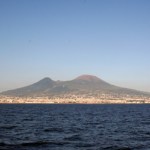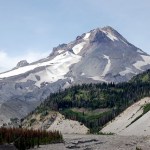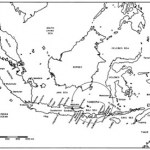pyroclastic flow
Monday is here again already ...
A pyroclastic flow from Soufriere Hills heading towards the ocean. Note the large volcaniclastic debris fan being formed by repeated flows. Dated March 2006.
The "Science Advisory Committee" at Montserrat in the West Indies suggests that the current eruption of Soufriere Hills on the small island could be drawing to a close. This is mostly based on the ever-decreasing seismicity under the volcano and that the volcano has not experienced any new dome growth or explosions over the last 6 months. Gas emissions have remained relatively constant over the last 18…
Shiveluch volano in Russia.
Just like last summer seemed like a busy time for the Aleutians (Cleveland, Okmok and Kasatochi), this summer could be dubbed the "summer of Kamchatka-Kurils" (alright, it isn't that catchy, sorry). The biggest news was/is, of course, the sizeable eruption from Sarychev Peak in the Kuril Islands, but not to be outdone, Shiveluch on the Kamchatka Peninsula has starting playing catchup.
KVERT is reporting that Shiveluch produced a 7 km / 23,000 foot ash column on Monday, with increased seismicity to go along with the explosions. These explosions are generating the…
Sarychev Peak erupting on June 12th. Image taken on the ISS, courtesy of the NASA EO.
The eruption as Sarychev Peak seems to be waning a bit, at least according to some of the latest images from the NASA Earth Observatory's collection of MODIS shots. The ash plume is less prominent - and strikingly more grey than before, possibly if it contains a higher proportion of water vapor than the earlier plumes. However, it isn't these brand new shots that captured my attention but rather one of the possibly most stunning volcano images I've seen in years (above). This captures Sarychev Peak as a…
The latest in my Volcano Profiles Series, we turn to Europe and Vesuvius. You could fill many, many volumes with the works produced on Vesuvius since Roman times. This profile will barely scratch the surface when it comes to the vast geologic and human history surrounding the volcano, but it is a start. If you want to learn more about the archaeology surrounding Vesuvius, try visiting Blogging Pompeii.
VOLCANO PROFILE: MT. VESUVIUS
Mt. Vesuvius in Italy. Image courtesy of Dario Leone.
Location: Italy
Height: 1,281 m / 4,203 ft
Geophysical location: The tectonics in the Mediterranean are…
The clock is ticking for the new dome growing at Redoubt to collapse. What will happen if/when it does collapse? Good question!
The new dome at Redoubt. Image courtesy of AVO/USGS, taken by Game McGimsey, April 30, 2009.
Most likely, the following will occur:
First, extrusion of lava will cause the dome to over-steepen, precipitating the collapse (although a large seismic event could also trigger collapse as well). An excellent example of this is the spine that grew at Mont Pelee on Martinique in 1902 before the famous eruption that destroyed St. Pierre and killed >30,000 people.
When it…
Back in the days when Eruptions was on Wordpress, I held a vote about what volcano should be the next to be profiled on this blog. The winner was Mt. Hood in Oregon, and after much waiting, the profile is here. I will actually be out of town until Monday doing some house shopping in this little town. Enjoy this look at one of the most picturesque (and hazardous - #4 in fact) volcanoes in the lower 48 states.
VOLCANO PROFILE: MT. HOOD
Mt. Hood, Oregon in August 2008 taken by Erik Klemetti.
Location: Oregon, U.S.A.
Height: 3,426 m / 11,240 ft
Geophysical location: Along the Cascade arc where…
Redoubt with a prominent steam plume on April 7,2009. Image courtesy of Robert Cole/AVO
Eruptions reader Brian just pointed out that AVO has posted a new webcam (well, a redirectly webcam) for the volcano and I thought it deserved its own post. This new angle gets you right up to the new dome forming on the volcano. The Hut webcam is now zoomed into the area where new magma is extruding - mostly passively - from this eruption. From this vantage point, when conditions permit - you might be able to get a good view of the dome-collapse block & ash flows that typically accompany silicic dome…
Chaiten erupting on January 19, 2009. Image courtesy of the NASA Earth Observatory.
It is hard to believe that we are less than one month away from one-year anniversary of the beginning of the eruption at Chaiten (and with it, the one-year anniversary of this blog!) The volcano in southern Chile is still erupting away, creating at least 2 dome complexes within the older caldera. These domes have been experiencing periodic collapses, creating block & ash flows, some of which have made it out of the caldera and down close to the ghost town of Chaiten. Along with the block & ash flows,…
Tambora, Indonesia
There are big eruptions, then there are big eruptions. On April 10, 1815, Tambora, a volcano in Indonesia, produced one of the largest eruptions in human history. This eruption produced what became known as the "year without a summer" after the volcanic aerosols from the eruption produced some of the coldest summers in many parts of the world. The Tambora eruption in 1815 was a VEI 7, on a scale that goes to, well, 7*, putting it in a class of some of the largest and most violent eruptions imaginable - and I, for one, can hardly imagine what might happen if an eruption of…
Today looks to be a doubleheader of volcano news:
Redoubt
Image courtesy of AVO/USGS, taken by Rick Wessels. An infrared image of the north slope of Redoubt showing the hot, new dome material and hot block & ash flows confined to the valley.
At 11:30 AM yesterday, AVO put Redoubt back to Orange/Watch alert status after the volcano seem to settle down to small steam/ash plumes. Less than 12 hours later (at ~6:30 AM Alaska time), the volcano produced another large explosive eruption, sending an ash column up ~50,000 feet / 15 km and producing what seems to be a significant lahar that…
Image courtesy of AVO/USGS by James Isaak. Photo taken 3/31/2009.
No, this isn't Battlestar Galactica, but the same can be said for the Drift River Oil Terminal: this has all happened before and will all happen again. Coast Guard officials have (finally) decided to move ~6.3 million gallons of crude oil from the Chevron-owned Drift River Oil Terminal at the base of Redoubt. The oil terminal has been a flashpoint since Redoubt began to make noise earlier this year and even up until yesterday, it was unclear what, if any, action the Coast Guard might take with the facility. It had been shut…
Image courtesy of AVO/USGS. Taken by Cyrus Read
Based on the current levels of seismicity over the past 36 hours, AVO has returned Redoubt to Orange/Watch status from Red/Warning. This doesn't mean that the eruption is over, just that things have settled down a bit. Flights to and from Anchorage have resumed as well. You can read the full statement here, but the take-home messages are:
AVO expects this to be like the 1989-1990 dome-building eruptions, although no new dome magma has been seen yet (mostly thanks to poor weather).
Dome collapse will likely generate pyroclastic flows with…
The people who remain in Chaiten face the potential for a devasting pyroclastic flow, so says Jorge Muñoz of the SERNAGEOMIN in Chile. The volcano is still producing large ash columns on Tuesday and a flyover of the dome forming inside the caldera has lead to the concern that a collapse on a larger scale than those seen last week could wipe out the town for good.
The government hopes news like this from volcanologists might convince the last remaining residents of Chaiten to leave, but no indication of this has come to pass. In fact, things sound like they're getting heated in the fight…
It is hard to believe that the eruption at seem to come out of nowhere at Chaiten started over 8 months ago now, and apparently is still not showing many signs of abating. I did get a chance to see some great talks and posters at AGU last month about the Chaiten eruption, with the key points I took away being that Chaiten is erupting a very crystal poor rhyolite (<1% crystals) and that it seems that the source of the magma is relatively deep in the Andean crust. Also, there are some indications that the eruption at Chaiten may have been tectonically instigated - i.e., that earthquakes in…
I just got back from a 4 day field trip to the Long Valley Caldera in eastern California, so I'm a little behind on posting. The field trip was great and I had a chance to see a lot of pumice, a lot of welded tuff (in the form of the Bishop Tuff, the large ignimbrite that erupted from the Long Valley Caldera ~760,000 years ago) and got to lead the part that looked at the Mono domes (too bad snow covered the Inyo Domes). Pictured above some puffed obsidian - the layers are obsidian and vesicle-rich obsidian - that were erupted, cooled, expanded and cracked (known as "breadcrusting"). This is…
After nearly a year and a half of little lava dome growth at Soufriere Hills in the West Indies, this past July 26th, the volcano erupted new dome material. Why do I remind us of this, you ask? Well, the Scientific Advisory Committee at Montserrat feel that the dome growth might be restarting in earnest:
Since August, any new supply of lava has been minimal. Thus while there is evidence that the eighteen-month long pause in lava dome growth may be coming to an end, it has not happened yet.
The most troubling event, in their minds, is the new activity at the Gages Wall vent, which means that…
Sorry about the dearth of posts. It has been a busy week here in Davis and I've been a little distracted by the upcoming election. Combined with the relative lack of volcano news this week, the posting has been lackluster.
However, that being said, I will try to make up for some of it by starting my Volcano Profiles series that will bide the time between volcano news. I start with a volcano that was suggested by Eruptions reader Thomas Donlon: Rabaul.
VOLCANO PROFILE: RABAUL
Â
Location:Â Papau New Guinea
Height: 688 m
Geophysical location:Â Boundary…
Â
UPDATE 10.9.08: This photo is not from the current eruption (see the comments below), so disregard any comments I might have about the current state of activity.
Contrary to some of the earlier reports, the eruption at Soputan in Indonesia might be more impressive than previously though. Pictures of the eruption (above) show a fairly healthy eruption column coming from the volcano, although it is hard to tell if the image is just an eruption column or a column with an associated column-collapse pyroclastic flow heading down the far side of the volcano (in the picture). The former…
Two volcanoes on the island of Luzon look like they might be primed for activity, at least according to PHILVOLCS, the Philippine Institute of Volcanology and Seismology. Both Mayon and Taal (above) are showing signs of increased seismicity. Only Mayon is actively steaming right now and the volcano had a mild ash eruption on August 10 as well. Officials in the Philippines have both volcanoes on Alert Level 1 (potential activity).
Taal is actually part of a bigger system that occupies a 15 by 20 km caldera. The island where most historic activity has occurred is made up of a…
It seemed like events at Soufriere Hills had been heading for a dome collapse for the past few week and sure enough, part of the summit dome collapsed last night, producing pyroclastic flows that reached the ocean along with a 40,000 foot ash column. The report I received from the Montserrat Volcano Observatory offered the following details:
The collapse started at 11:27 pm local time on Monday 28th July 2008
without any precursory activity. Part of the western side of the lava
dome collapsed generating pyroclastic flows that reached Plymouth and
the sea.
There were also a few explosions…


